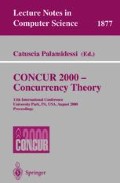Abstract
The dynamics of reactive systems, e.g. CCS, has often been defined using a labelled transition system (LTS). More recently it has become natural in defining dynamics to use reaction rules - i.e. unlabelled transition rules - together with a structural congruence. But LTSs lead more naturally to behavioural equivalences. So one would like to derive from reaction rules a suitable LTS.
This paper shows how to derive an LTS for a wide range of reactive systems. A label for an agent a is defined to be any context F which intuitively is just large enough so that the agent Fa (“a in context F”) is able to perform a reaction. The key contribution of this paper is a precise definition of “just large enough”, in terms of the categorical notion of relative pushout (RPO), which ensures that bisimilarity is a congruence when sufficient RPOs exist. Two examples - a simplified form of action calculi and term-rewriting - are given, for which it is shown that sufficient RPOs indeed exist. The thrust of this paper is, therefore, towards a general method for achieving useful behavioural congruence relations.
Access this chapter
Tax calculation will be finalised at checkout
Purchases are for personal use only
Preview
Unable to display preview. Download preview PDF.
References
Ariola, Z. M. and Klop, J. W., Equational term graph rewriting. Fundamentae Informaticae, 26(3,4), pp. 207–240, 1996.
Abadi, M. and Gordon, A. D., A calculus for cryptographic protocols: the spi calculus. Proc. Fourth ACM Conf. on Computer and Communications Security, Zürich, ACM Press, pp. 36–47, 1997.
Baeten, J. C. and Weiland, W. P., Process algebra. CUP, 1990.
Berry, G. and Boudol, G., The chemical abstract machine. Theor. Comp. Sci. 96, pp. 217–248, 1992.
Cardelli, L. and Gordon, A. D., Mobile ambients. Foundations of System Specification and Computational Structures, LNCS 1378, pp. 140–155., 1998.
Corradini, A. and Montanari, U., An algebra of graphs and graph rewriting. Proc. Fourth Biennial Conf. on Category Theory and Computer Science, LNCS 530, pp. 236–260, 1991.
Fournet, C., Gonthier, G., Lévy, J.-J., Maranget, L., and Rémy, D., A calculus of mobile agents. Proc. CONCUR’96, LNCS 1119, pp. 406–421
Gardner, P., Closed action calculi. Theor. Comp. Sci. 228(1,2), pp. 77–103, 1999.
van Glabbeek, R. J., The linear time-branching time spectrum. Proc. CONCUR’90, LNCS 458, pp. 278–297, 1990.
Groote, J. F. and Vaandrager, F. W., Structural operational semantics and bisimulation as a congruence. Information and Computation 100(2), pp. 202–260, 1992
Hasegawa, M. Models of sharing graphs (a categorical semantics of let and letrec). PhD thesis, LFCS, University of Edinburgh, 1997.
Hoare, C.A. R., Communicating Sequential Processes. Prentice Hall, 1985.
Jeffrey, A. and Rathke, J., Towards a theory of bisimulation for local names. Proc. LICS’99, IEEE Press, pp. 56–66, 1999.
Joyal, A., Nielsen, M. and Winskel, G., Bisimulation from open maps. Information and Computation 127(2), pp. 164–185, 1996.
Milner, R., Communication and Concurrency. Prentice Hall, 1989.
Milner, R., Functions as processes. Mathematical Structures in Computer Science 2(2), pp. 119–141, 1992.
Milner, R., Calculi for interaction. Acta Informatica 33(8), pp. 707–737, 1996.
Milner, R., Parrow, J. and Walker, D., A calculus of mobile processes, Parts 1 and 2. Information and Computation 100(1), pp. 1–77, 1992.
Milner, R. and Sangiorgi, D., Barbed bisimulation. Proc. ICALP’92, LNCS 623, pp. 685–695, 1992.
Pitts, A. M. and Stark, I. D. B., Observable properties of higher order functions that dynamically create local names, or: What’s new? Proc. MFCS, LNCS 711, pp 122–141, 1993.
Park, D., Concurrency and automata on infinite sequences. Lect Notes Comput Sci 104, 1980.
Sewell, P., From rewrite rules to bisimulation congruences. Proc. CONCUR’98, LNCS 1466, pp. 269–284, 1998. [Revised version to appear in a special issue of Theor. Comp. Sci.]
Sewell, P., Global/local subtyping and capability inference for a distributed picalculus. Proc. ICALP’98, 4 1443, pp. 695–706
Turi, D. and Plotkin, G. Towards a mathematical operational semantics. Proc. LICS’97, IEEE Press, pp. 280–291, 1997.
Author information
Authors and Affiliations
Editor information
Editors and Affiliations
Rights and permissions
Copyright information
© 2000 Springer-Verlag Berlin Heidelberg
About this paper
Cite this paper
Leifer, J.J., Milner, R. (2000). Deriving Bisimulation Congruences for Reactive Systems. In: Palamidessi, C. (eds) CONCUR 2000 — Concurrency Theory. CONCUR 2000. Lecture Notes in Computer Science, vol 1877. Springer, Berlin, Heidelberg. https://doi.org/10.1007/3-540-44618-4_19
Download citation
DOI: https://doi.org/10.1007/3-540-44618-4_19
Published:
Publisher Name: Springer, Berlin, Heidelberg
Print ISBN: 978-3-540-67897-7
Online ISBN: 978-3-540-44618-7
eBook Packages: Springer Book Archive

